Cleaning Out A Pond: When & How To Clean A Garden Pond Safely
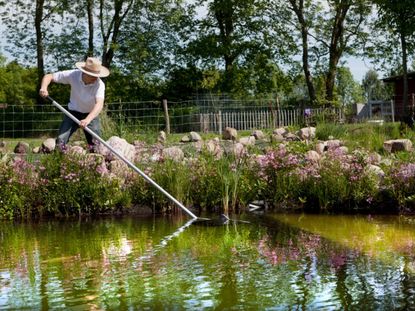

It sometimes feels like the garden chores are never done. There's so much to prune, divide, amend, and replant, and it just goes on and on forever - oh, and don't forget your garden pond cleaning. As beautiful as they are, garden ponds require maintenance to look their best, and although cleaning out a pond isn't rocket science, doing it properly will make the process go much more smoothly, especially if plants or fish call your pond home.
Outdoor Pond Cleaning
It's important to consider what is living in your pond before planning a regular cleaning. Ponds with only plants as constant inhabitants are usually cleaned in the spring, but those with fish or other permanent aquatic life should be cleaned in the fall, before temperatures fall dramatically. Fish are typically weaker in the spring and can't handle as much stress at this time, which is why koi and fish pond cleaning is recommended at the end of the growing season, when fish are at their healthiest. The frequency of pond cleaning is another important consideration. It's not a good idea to clean them more than once a year, and less than once every three to five is even better. If you keep the pond clean throughout the year by using nets to prevent leaf accumulation and removing plant debris as it begins to wilt, you'll need to clean less often. The addition of pond filtration systems can further simplify your pond cleanings.
How to Clean a Garden Pond
When temperatures are below 70 degrees Fahrenheit (21 C.), grab your pond cleaning tools and get ready to get dirty. You may be able to get away with a quick debris removal using a pool net, but if the pond is very dirty, you'll need to remove most of the water as well. Drain or siphon it into a large container, like a plastic trash can. When less than six inches (15 cm.) of water remains, dip the fish out of the pond and into the water holding tank. Cover the container with a net so the fish don't jump out and predators don't find their way in. Remove any plants to a shaded, moist area to prevent stress as you clean the pond. Once the pond is as empty as you can get it, rinse the pond walls thoroughly and scoop out any accumulated muck, dumping it into your compost bin or garbage. As soon as the pond is cleaned out, refill it slowly over several hours to help keep the water temperature as high as possible. Adding pond enzymes at this time can help break down small amounts of remaining debris and dechlorinators will make the water safe for your pond residents. Replace the plants and fish when the water levels are close to normal and the temperature is within about five degrees of the water when you removed it. Replacing some of the missing water with that from the holding tank will help speed up the re-establishment of helpful bacterial colonies and other microscopic organisms.
Gardening tips, videos, info and more delivered right to your inbox!
Sign up for the Gardening Know How newsletter today and receive a free download of our most popular eBook "How to Grow Delicious Tomatoes."

Kristi Waterworth was a regular contributor to Gardening Know How for many years, answering countless queries on plant pests and diseases.
-
 Urban Composting Guide: How To Compost In The Middle Of The City
Urban Composting Guide: How To Compost In The Middle Of The CityUrban composting does not have to be daunting. You can compost in the city, and maybe even try some urban worm composting!
By Mary Ellen Ellis
-
 Shrub Diseases And Pests To Watch Out For
Shrub Diseases And Pests To Watch Out ForShrub diseases and pests can be challenging. Learn how to recognize and eradicate them before they can present a danger to your plants.
By Susan Albert
-
 Flowering Pond Plants - Growing Aquatic Flowers
Flowering Pond Plants - Growing Aquatic FlowersAdding flowering pond plants to natural and manmade water features can be an easy way to quickly beautify a space with lush greenery and vibrant bursts of seasonal color. Read on for more.
By Tonya Barnett
-
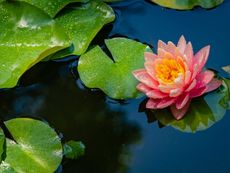 Full Sun Aquatic Plants - Full Sun Floating Pond Plants
Full Sun Aquatic Plants - Full Sun Floating Pond PlantsThere are pros and cons to putting a pond in full sun, but it's very doable. Here are some ideas to get you started.
By Mary Ellen Ellis
-
 Echinodorus Creeping Burhead – Information On Creeping Burhead Plant Care
Echinodorus Creeping Burhead – Information On Creeping Burhead Plant CareCreeping burhead plants are members of the water plantain family and commonly used in freshwater aquariums or outdoor fishponds. Echinodorus creeping burhead is native to the eastern half of the United States. To learn more about the creeping burhead plant click the following.
By Laura Miller
-
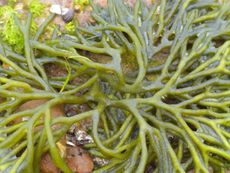 What Is A Saltwater Aquarium: Plants For Saltwater Aquariums
What Is A Saltwater Aquarium: Plants For Saltwater AquariumsBuilding and maintaining a saltwater aquarium requires some expert knowledge in choosing the right plants. Here are some choices to start with.
By Mary Ellen Ellis
-
 Outdoor Aquarium Ideas: Putting A Fish Tank In The Garden
Outdoor Aquarium Ideas: Putting A Fish Tank In The GardenAquariums are generally made for inside the house, but why not have a fish tank outside? Click here for tips and ideas on backyard aquariums.
By Mary Ellen Ellis
-
 Fish That Eat Plants – Which Plant Eating Fish Should You Avoid
Fish That Eat Plants – Which Plant Eating Fish Should You AvoidGrowing plants with aquarium fish is rewarding, but if you want to combine plants and fish, learn what aquarium fish to avoid. This article will help.
By Mary H. Dyer
-
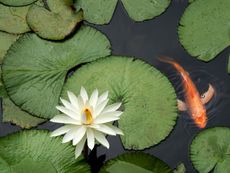 Is Pond Fertilizer Bad For Fish: Learn About Fish Safe Fertilizer
Is Pond Fertilizer Bad For Fish: Learn About Fish Safe FertilizerUsing fertilizer around fishponds must be done with care. Excess nitrogen causes algae, but can also contaminate the water and affect fish. Learn more here.
By Bonnie L. Grant
-
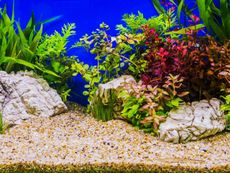 What Is Aquascaping – Creating An Aquarium Garden
What Is Aquascaping – Creating An Aquarium GardenAquatic gardening can be a rewarding endeavor, especially when aquascaping. Click this article to learn more about creating an aquarium garden.
By Nikki Tilley